IS ASTROPHYTUM 'SUPER KABUTO' - ASCAP?
By Igor M. Skoulkin, Ph.D.
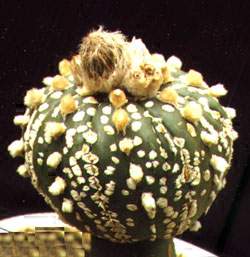 |
| Photo 1. The parental plant of 'Super Kabuto' acquired from Koehres, 3 years old. |
It is safe to say that in the last 20 years Astrophytum asterias 'Super Kabuto' (SK) with an unusually fuzzy epidermis became one of the most popular cacti. The origin of the form is not fully understood though. According to T. Sato (1993), all SK are descendants of a single mutant cactus found by a Japanese cactophile M. Takeo in one of American collections in 1981. Another version was suggested by Y. Matzuoka on the Internet (1998). He said that the first 'Super Kabuto' and 'Miracle Kabuto' were natural mutants imported from Mexico in 1980. Further forms were created as a result of intraspecific hybridization (here and further italic is the author's – I. S.)
I was lucky to obtain seeds of SK from Koehres company in 1998. One part of the seedlings was grafted onto Selenicereus, another part onto Hylocereus, and some of them were left on own roots. All the un-grafted seedlings died in the first year and a half. As it usually happens, the first to die were the most beautiful seedlings with the thickest fuzz. The seedlings grafted onto Selenicereus grew faster than those onto Hylocereus, and in summer 1999 one of them bloomed (photo 1). At that time it was barely a year old. This, of course, is not a sensation, but a remarkable fact. I would like to quote Walter Haage and Otakar Sadovsky, the prominent experts in Astrophytum hybridization: "Grafted A. asterias sometimes bloom by the end of the second year of their life". They also indicate that "early blooming is a feature of hybrids".
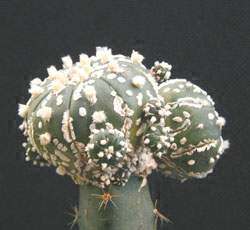 |
| Photo 2a. Photo 2a, 2b, 2c - 'F1' hybrids obtained as a result of crossing between 'Super Kabuto' x A. asterias, 1.5 years old. |
Since the other SK having thicker fuzz, did not want to bloom in the second or even in the third year of their life, in 1999-2001 the flowers of the single blooming SK were pollinated with the pollen of a usual A. asterias, which I had used for producing normal A. asterias seeds and had no doubts in its purity.
A. asterias 'Super Kabuto' x A. asterias were the first F1 hybrids I created. During the first half-year of growing on their own roots all of them looked more or less like regular A. asterias – green, paunchy and bald. Actually, some of the F1 hybrids approached the original form of SK in terms of the fuzz thickness, though they never surpassed it.
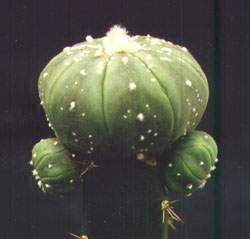 |
| Photo 2b. |
Some of the F1 hybrids were grafted in 2000 (photo 2 a, b, c). To my great surprise, two plants having different degree of fuzziness, started to produce offshoots in the first year (photo 2 a, b). It was surprising, because the true A. asterias almost never gives offshoots. If, by some magic way they develop offshoots, they do it from cambium tearing all peripheral tissues, but not from areolas. As you can see, SK hybrids develop their offshoots from areolas indeed.
Meanwhile I performed several attempts of reciprocal crossing, that is pollinating A. asterias with pollen of SK. Most of the attempts failed, but in the spring of 2001 two fruits set with about 70 seeds. Out of them I raised 52 seedlings, which are now about 6 months old (photo 3). Twenty-six of them, or 50% look like usual A. asterias or A. asterias х SK hybrids (photo 3, right). The other twenty-six seedlings look very unusual -- they formed sharp ribs and clearly shown the spines (photo 3, left)! Such appearance is rather typical for A. CAPAS or A. ASCAP (hybrids of A. asterias and A. capricorne), but it never occurs to A. asterias.
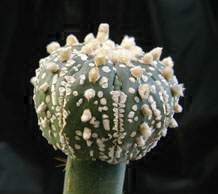 |
| Photo 2c. |
Skeptics who are especially numerous among cactophiles, would probably say that pollination was not done carefully, and some pollen of A. capricorne had gotten onto the stigma of A. asterias by insects, for instance. It may sound convincing but not a single A. capricorne was blooming in the greenhouse at that time. It means that the only source of A. capricorne genes were the genomes of the crossbred plants!
Taking into consideration that the original plant was a genetically pure A. asterias, it can be concluded that the SK species initially contained a significant number of A. capricorne genes. It means that either the first SK was a hybrid with A. capricorne, or Japanese and German SK selectionists hybridized it with A. capricorne. Still, it's not clear why A. capricorne genes did not show up in the crossbreeding of SK and А. asterias.
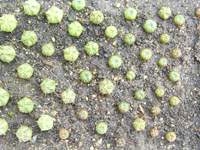 |
| Photo 3. Baby cacti. Phenotype splitting of 'F1' hybrids from reciprocal crossing between A. asterias and A. asterias 'Super Kabuto'. The seedlings are 6 months old. |
I would like to quote Haage and Sadovsky again: "F2 hybrids of CAPAS x CAPAS have less fuzz and spines... F2 remain small, even smaller than A. asterias... Like Echinopsis, they produce shoots". And further on: "Pure Astrophytum never forms shoots, even if the apex is damaged".
Let's sum it up. It is obvious that the 'Super Кabuto' genome contains not only A. asterias genes but also A. capricorne genes, and maybe others. T. Sato proved it indirectly by saying that "some maternal plants were not pure А. asterias. As a result spiny clones appear rather often" (Sato, 1993). Consequently, the name Astrophytum asterias cv. Super Kabuto is not quite correct.
LITERATURE
- "Internet interview", KiNTO (Cacti and Not Only), #3-1998
- W. Haage, O. Sadovsky, Kaktusy-Zvyezdy (Star Cacti), Moscow, 1973
- T. Sato, Astrophytum Handbook, Vol. 1 (Asterias family), 1993





